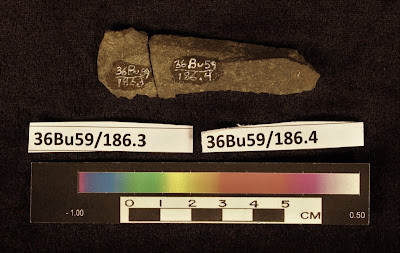My name is Alaina Helm, I am a
Junior at Oberlin College in Ohio and a Keystone intern in Archaeology for this
summer. Over the past several weeks and
for a brief month-long stint back in January, I have been working on a flake
refitting project here in The State Museum of Pennsylvania, Section of Archaeology. The project was supervised
by Dr. Kurt Carr, Senior Curator, and consists of an argillite debitage cluster
collected from the Eelskin Rockshelter (36Bu59) that was theorized to have been
created over a single knapping event.
Steve Nissly flint knapping
Analysis
began with the organization and cleaning of the entire assemblage of debitage.
Artifacts were cleaned using warm soapy water and a Sonicor ultrasonic cleaner,
similar to a jewelry cleaner. We also experimented with the use of diluted
vinegar water to remove patination, but it was found to be no more effective so
was not done on all pieces. Once cleaned, flakes were uniformly laid out on
trays for refitting by type as entire, proximal, medial, or distal pieces. A
small quantity of other materials was found amongst the debitage and separated
out that includes jasper, quartz, bone, and chert. A wide range of colors was
noted in the argillite which is generally black. We also found two biface
fragments, a proximal utilized flake, and an end scraper among the debitage.
Several weeks were spent attempting to fit
pieces together where flakes had come off each other or flakes had broken
apart. If successful, refitting a flake
cluster back together would allow for the study of stone tool creation through
flake reduction techniques. In the case of this cluster from the Eelskin Rock
Shelter, only five refits were found over several weeks of searching through
the hundreds of pieces in the collection. Methods used in attempting to match
related flakes together included; grouping by color, grouping by texture, and
grouping by type. Type attributes included
the shape of the bulb of percussion (Lipped, bulbar, etc.) and the shape/ size
of flake (length, width, thickness). These groupings did not reveal the
relatively large number of matches that could be expected in a chipping
cluster.
The
majority of the debitage demonstrates late stage and baton reduction techniques.
Late stage reduction is the process of reducing an already acquired raw
material into a complete tool. Almost all flakes are thin with several dorsal
flake scars. 68.4% of the proximal or entire flakes are lipped. Lipped flakes
are a key indicator of late stage baton production technologies.
Due to the small quantity of matched
pieces found and the variations in color and texture, there is a good chance
that although the lithic material first appeared to belong to a single chipping
event, it instead represents several knapping events. This conclusion is
additionally supported by the fact that there is a small amount of lithic materials
other than argillite present, as listed above. Other potential explanations for the high
quantity of debitage found together could include that the materials were part
of a rubbish pile or that several short knapping events occurred in the same
location.
example of color variation
This comparative analysis was an
exercise well suited for my studies, as it brought together my interests in
archaeology and geology. It provided useful experience in lithic analysis, and
although sometimes tedious and frustrating when days were spent with no matched
flakes found, was valuable in determining that the lithics cluster found at the
Eelskin Rockshelter was not the refuse of a single toolmaking event. This
project was ultimately beneficial to my own learning while also letting us
learn a little about the activities being performed on the site.
Thanks for reading my blog and I hope you will check back
for another blog post from me about the experimental archaeology test I
conducted on stone scrapers.
Bibliography
Justice, Noel D.
1987 Stone Age
Spear and Arrow Points of the Midcontinental and Eastern United States. Indiana
University Press.
Anonymous
n.d. Eelskin Rockshelter-36Bu159, anonymous manuscript
housed in the County Files, The State Museum of Pennsylvania, Section of
Archaeology, Pennsylvania Historical and Museum Commission, Harrisburg
Pennsylvania.






No comments:
Post a Comment